How Are Diamonds Made? Natural vs Lab-Created Explained
Two Paths, One Diamond Not all diamonds come from the same place — but they all start the same way. Pure carbon, crystalized under immense pressure and heat. Whether it…
Technically, a vintage engagement ring is one made more than 20 years ago. That means, as the years pass, more and more rings can be considered vintage. A ring more than 100 years old is considered antique, as well as vintage. Read on to learn how we further categorize antique and vintage rings by time-period.
Before going on: Check out the PriceScope Diamond Buying Guide
These pages may reference products from companies that help to support PriceScope.
The word vintage covers a lot of ground. Merriam-Webster defines Vintage as “old, recognized, and of enduring interest, importance, or quality.” In the world of jewelry, rings which are a few decades old are considered vintage. Technically, this can be as “young” as 20 years. Rings over 100 years old are considered antique rings.
Estate jewelry or estate diamond jewelry, refers to pieces which were previously owned and worn by someone. This includes antique and vintage rings, as well as rings which aren’t old at all. The only requirement is the secondary nature of ownership.
Rings from certain eras often have features in common. This can reflect styles and trends which were popular at the time but also can also relate to supply of precious metals and gemstones, the evolution of tools, even the evolution of lighting and environmental considerations over the years.
Where to buy Vintage Engagement Rings: Whiteflash, James Allen and Blue Nile are some of the world’s top sellers.
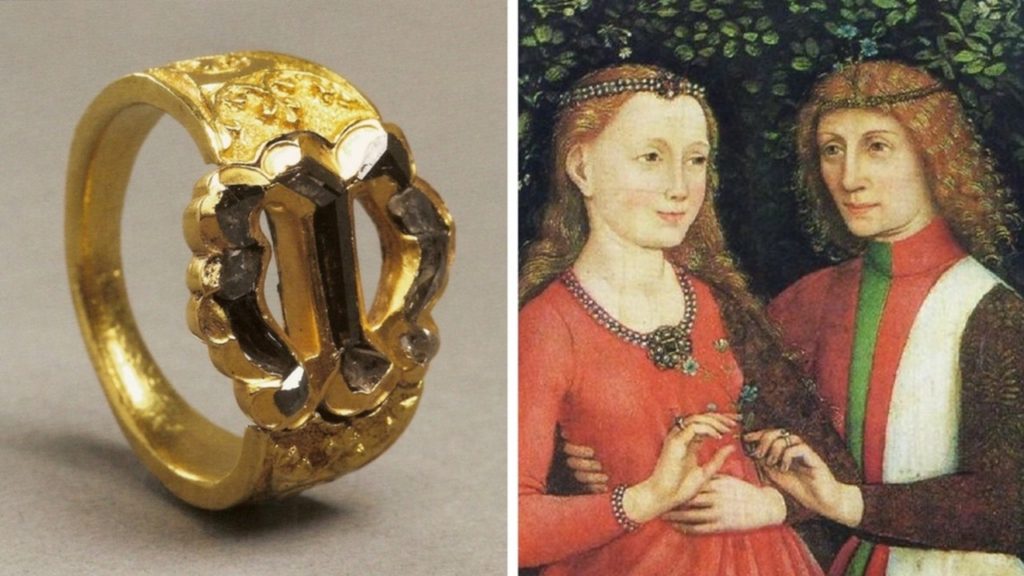
Archduke Maximilian of Austria began the diamond engagement tradition in 1477 but most people could not follow the tradition. The only known diamonds came from India at the time, so access to diamonds was limited to the most affluent people. The discovery of diamonds in Brazil in the early 1700s increased supply in Europe and, as they became more available, rings grew more elaborate, but diamond resources were not available to most people until the late 1800s.
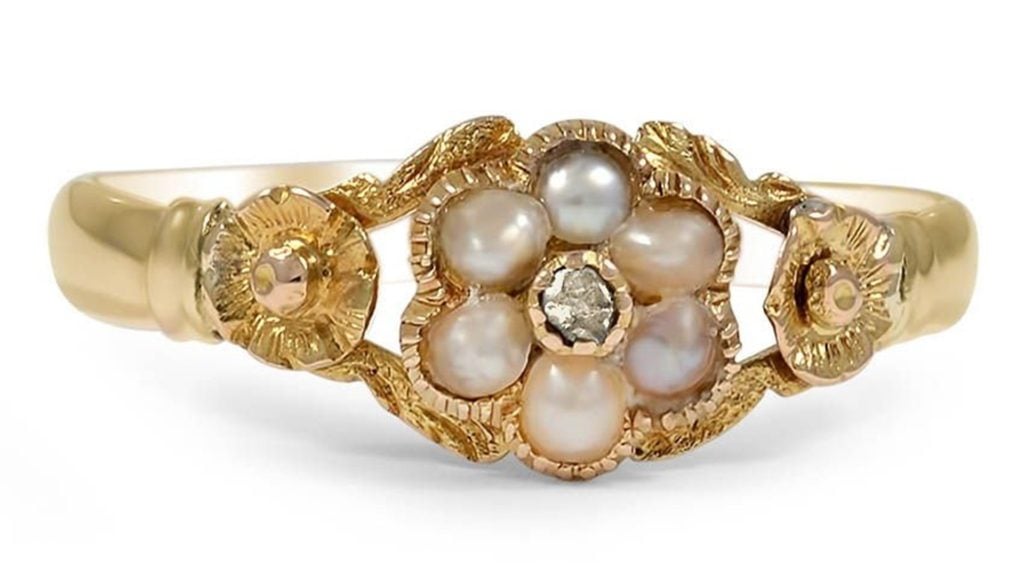
The Georgian Era describes the reigns of King George I through King George IV. Antique engagement rings during this period were characterized by nature and the outdoors. Plant embellishments included flowers, acorns, wheat stalks. Butterflies, doves, and other animals were also popular incorporations.
Since diamonds were still rare, pearls and colorful gemstones took center stage. The big three, ruby, sapphire and emerald were popular, but so were more affordable stones like garnet, topaz, and onyx. Diamonds did make the occasional appearance, usually as clusters of stones of tiny carat weight, rather than a single center stone.
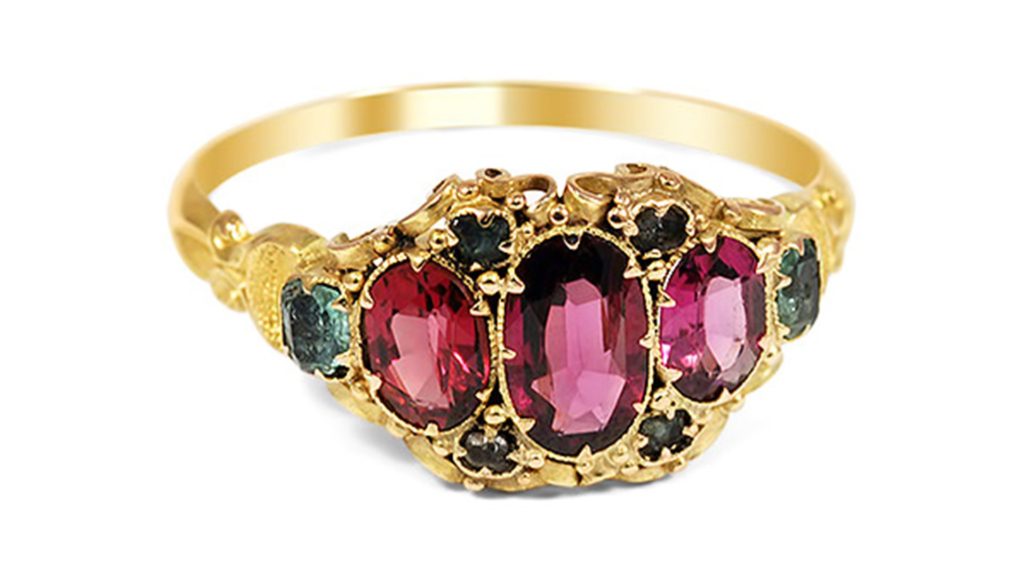
Queen Victoria’s love for her husband Albert is widely known and her love inspired that romance to trickle down to engagement rings. Albert had a ring for Victoria created in the shape of a snake with a large emerald. Hearts, bows, birds, and other romantic embellishments were popular motifs. Halos became increasingly used and pearls were also featured in jewelry during this period.
The early Victorian era, through 1861, was also known as the Romantic period. Diamonds continued to be used sparingly and, when employed, they continued to be groups of small stones clustered together. This period was characterized by colorful stones like emerald, ruby, garnet, and amethyst. Victoria’s favorite color was blue, so turquoise, and blue enamel also enjoyed popularity.
The mid-Victorian era, through 1885, was also known as the Grand period. The discovery of abundant diamonds in Africa in 1867 caused them to be incorporated with increasing frequency, often incorporated alongside colored gemstones. Engagement rings started appearing in silver or gold alloys.
The late Victorian era, through 1901, was known as the Aesthetic period. Diamonds started being used in engagement rings with greater and greater frequency, both as clusters and center stones. This period saw the diamond solitaire engagement ring become a reality. Mourning rings also rose in popularity, which is attributable to the early death of Victoria’s husband Albert and her extended period of mourning.
Diamond cuts changed over the course of the Victorian era. As diamond cutting tools and craftsmanship knowledge improved rose cuts and step cuts gave way to the fashioning of old mine and old European cut diamonds, predecessors to the modern round brilliant. In 1886, at the dawn of the late Victorian era, Tiffany & Company introduced the six-prong diamond solitaire engagement ring.
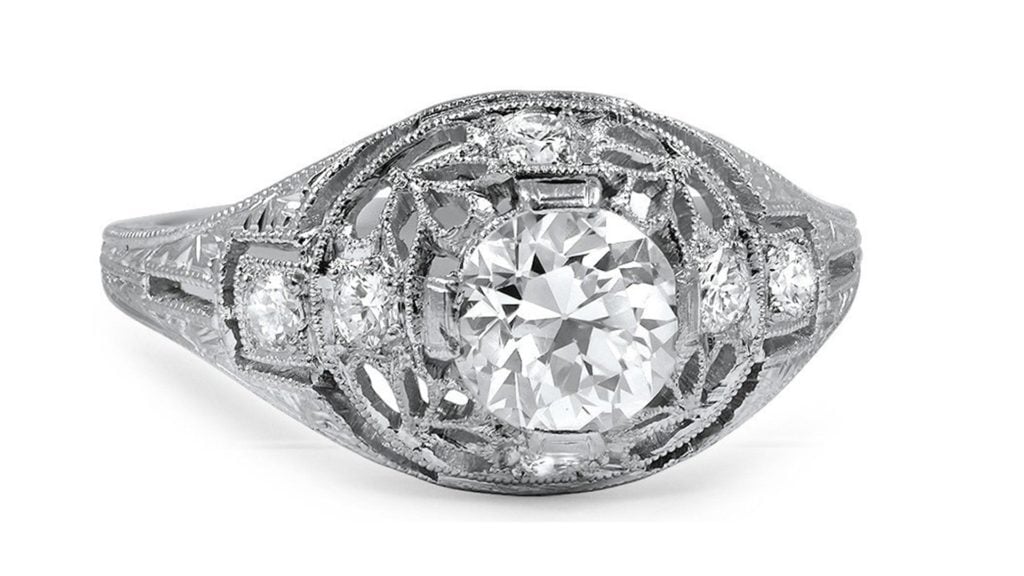
Victoria’s son, King Edward, oversaw “The Beautiful Age,” which many consider a continuation of his mother’s era. The main differences between Edwardian and Victorian jewelry are advances in jewelry making which make Edwardian jewelry more refined. Floral motifs were frequently employed, reflecting Queen Alexandra’s love of flowers. Descriptors of the style are light, lacy, and ethereal. Edwardian rings reflect a type of elegance and grace seldom seen in today’s styles.
Platinum was the favorite metal of the era, but yellow and rose gold remained popular. More antique diamond engagement rings flourished during this time due to continued diamond supply from Africa. Pearls and diamonds were common center stone choices.
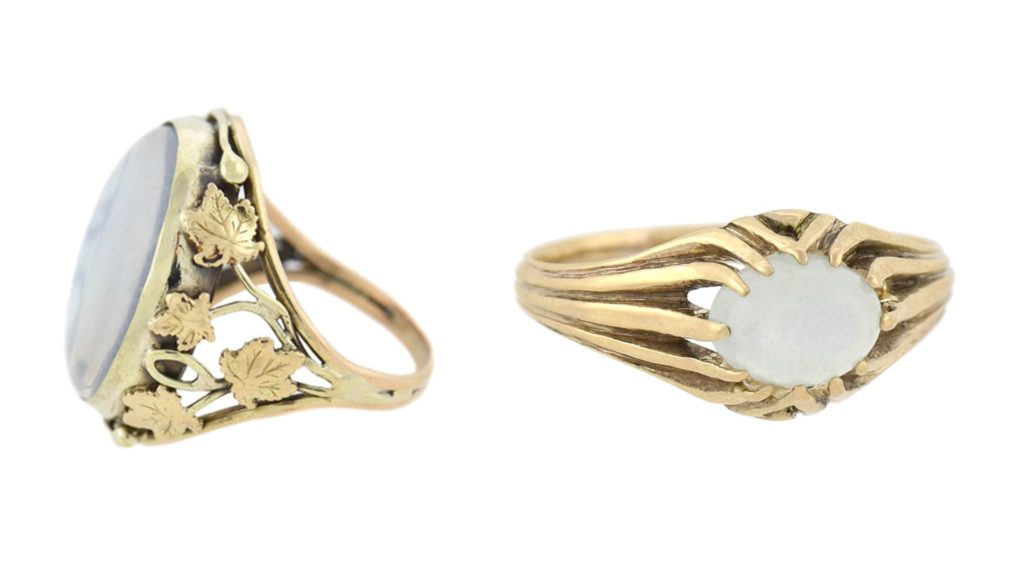
Art Nouveau was an artistic movement in France which overlapped the late Victorian and Edwardian eras. Described as “over the top” by many, it reflected a rejection of the industrial revolution by artists and jewelers of the time, as well as a fear that too many women starting to work outside the home. Nature and femininity were exaggerated in different pieces, with flowers, insects, fairies, mermaids depicted in a sexualized manner that had never been seen before.
White gold and platinum were the preferred metals, though pieces were also made from yellow gold and silver. Diamonds were rejected by many art nouveau designers, but the pearl was widely celebrated. Other popular gemstones included moonstone, opal, carnelian, emerald, ruby as well as translucent enamel. The era was brought to an end by the start of World War I.
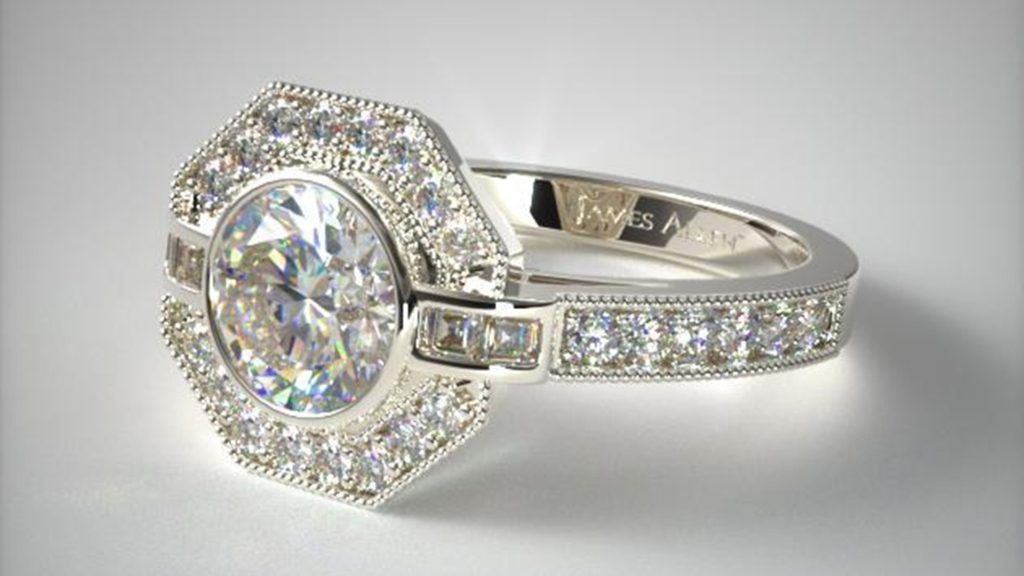
The art deco period took cues from Art Nouveau in its departing from Edwardian styles. Instead of light, curvy filigree art deco engagement rings used bold, symmetrical geometry, repeating patterns, and architectural designs. Continuous improvement in tools and techniques allowed jewelers to add more detail, so rings started incorporating milgrain; a metalworking technique where tiny metal beads are added, typically to create an ornate border.
Diamonds continued expanding in popularity through the first half of the era, with greater use of step-cuts like emeralds and Asschers. Rubies, sapphires, and emeralds were also in frequent use. During the great depression of 1929-1939, however, consumers who could not afford diamonds or expensive gemstones turned to more affordable stones such as garnet, citrine, amethyst, jade, onyx and glass.
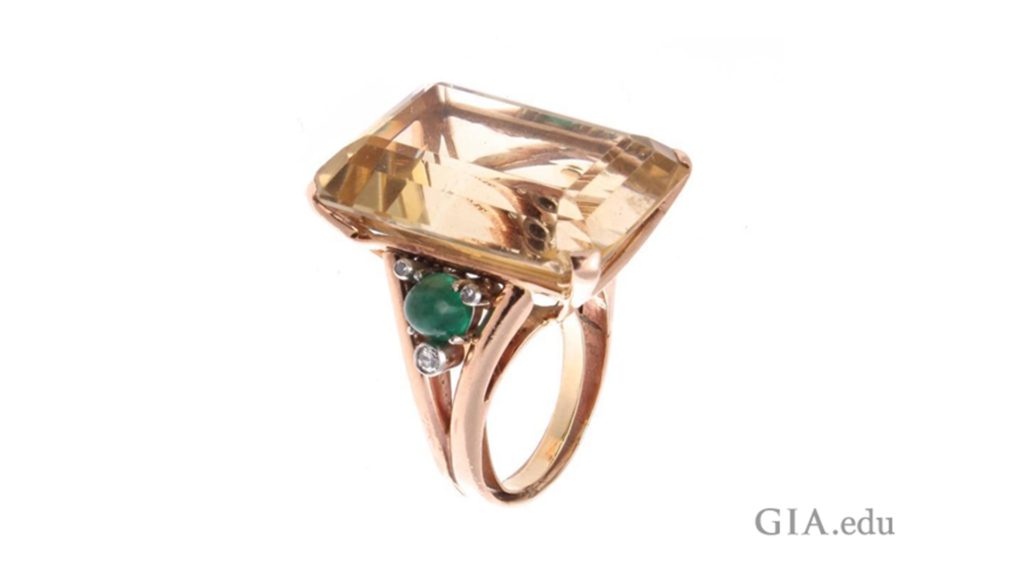
The Retro Era was ushered in by the conclusion of the great Depression in 1939 and World War II in 1945. Designs became big and bold, with clean, simple lines. These designs were thought to celebrate the bold lines of tanks, planes, and other machines of war. Older retro era rings were frequently made from palladium or silver, while platinum was reserved for the war effort, after which platinum made a big comeback. White gold also emerged due to shortages of platinum and many rings were two-toned, using both yellow and white gold.
The size of the center stones grew notably. Gemstones were both large and colorful. Most notably, the introduction of “A Diamond Is Forever” as a slogan stimulated the mass popularization of diamonds as an engagement ring tradition. During World War II an old European custom was revived, where the groom and the bride both receive wedding bands – a tradition which continues today.
The mid-century era welcomed a return to prosperity and diversity in jewelry style and substance.
There are several reasons to buy a vintage engagement ring.
Existing vintage engagement rings have practically no carbon footprint. The precious metals and gemstones were mined in previous eras, which is a plus for those seeking carbon neutral products. For consumers concerned about the ethics of mining and labor, vintage ring is also a safe choice. While there is no way to know the details of its origins, those origins are in the past.
Many consumers believe most engagement rings look similar with one another. The choice of a vintage ring, unique in its appearance, is something that could cause one to stand out from the crowd, feel special, or both.
A vintage engagement ring has history and sentimentality attached to it. Couples regularly choose to use heirloom rings, passed down from previous generations.
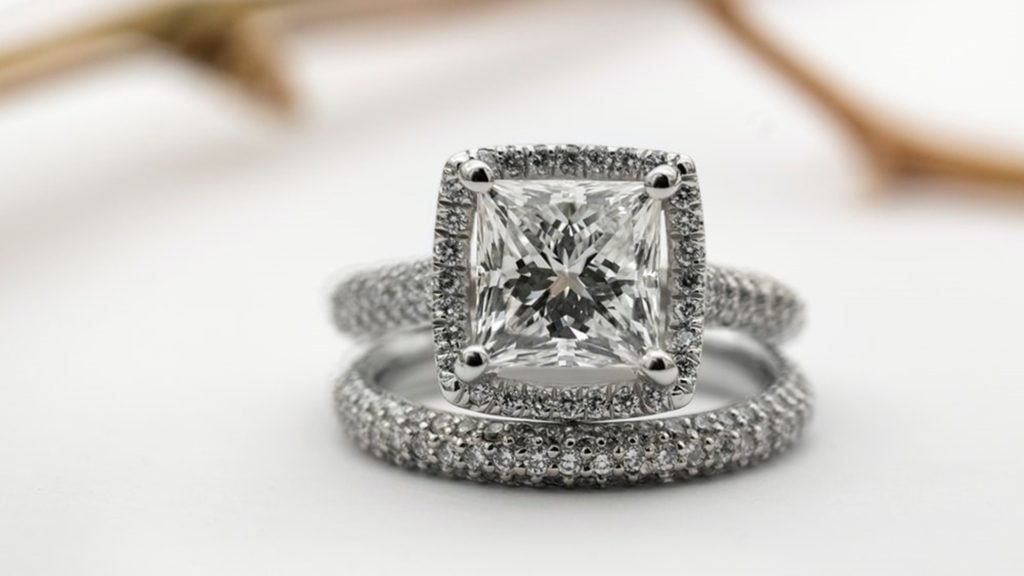
Yes. No. Maybe.
Modern jewelry is predictable since the price tag reflects the current market price for the gemstones and metal. Antique and vintage pieces are valued on their stones and metal as well, with additional factors like rarity and potential significance.
When seeking an authentic antique or vintage ring It can be challenging to define a “price range,” given the additional factors involved.
There are modern rings in vintage styles. While they don’t have the historical significance or carbon neutral status of authentic rings from the past, they are more predictable in terms of pricing.
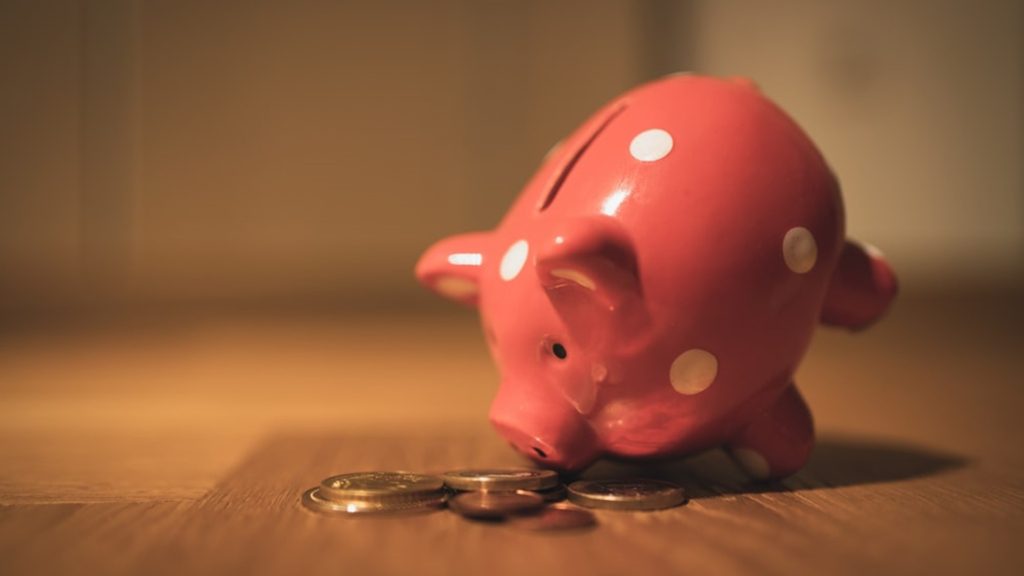
Three great options for vintage engagement ring style are Whiteflash, James Allen and Blue Nile.
Click the links here to purchase vintage engagement style rings from Whiteflash, James Allen and Blue Nile.
Get fast answers to any question: Ask our community of unbiased independent helpers.
Ready to find your diamond?
People also ask
An engagement ring is used to pop the question. A wedding ring is given at the wedding. They can be one and the same. Or you can present two separate rings. Read about the differences on our page covering engagement ring vs wedding ring.
The price of a diamond engagement ring is primarily connected to the price of the diamond. Check out our Diamond Price Guide to see how different factors impact a diamond’s price. We have also included a diamond price calculator for you to see today’s prices in real-time, based on more than 500,000 diamond listed in our search engine.